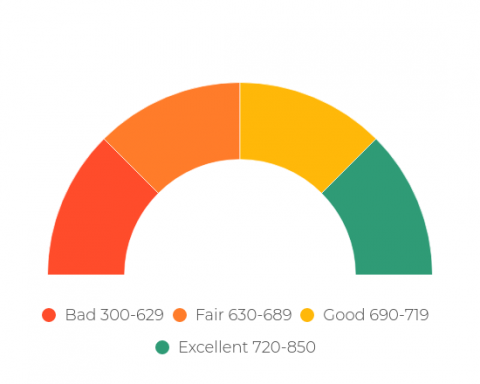 You know your credit score matters. Your score helps determine how easy it is for you to get financing – as well as the kind of interest rate a lender will offer you. That’s a big deal when it comes to something like buying a car or a house. The difference between a 4% interest rate on a mortgage, for example, and a 5% interest rate can add up to tens of thousands of dollars over time.
You know your credit score matters. Your score helps determine how easy it is for you to get financing – as well as the kind of interest rate a lender will offer you. That’s a big deal when it comes to something like buying a car or a house. The difference between a 4% interest rate on a mortgage, for example, and a 5% interest rate can add up to tens of thousands of dollars over time.
There’s a real and tangible cost to carrying around a bad score. So how can you ensure your maintain an excellent credit score throughout your life?
Start by understanding what actually goes into your most important credit score. That’s your FICO score, and it’s so important because it’s the one lenders look at when evaluating you after you apply for something like a credit card or loan.
The Biggest Influence on Your Score: Payment History
FICO looks at a number of factors to figure out where on the scale between the lowest score (300) and the highest (850) your credit score should be. These factors are weighted, meaning some of them influence your score more than others.
 And the one that will impact your score more than any other is your payment history. It determines 35 percent of your score.
And the one that will impact your score more than any other is your payment history. It determines 35 percent of your score.
Payment history is pretty much what it sounds like: your history of payments on money you owe. That includes credit card balances, mortgage statements, loans, and other bills.
Whether or not you paid what you owed is important. But paying on time counts, too. If you frequently miss payments or make late payments, that will drop your credit score.
Paying something is better than not paying at all, but if you want an excellent credit score you need to make your payments in full and on time. You can make that easier by:
- Not charging more than you can afford to repay to your credit card (or simply using cash instead of plastic to avoid that problem altogether)
- Setting up automatic payments on your bills and statements
- Creating calendar reminders and alerts so you don’t miss due dates if you don’t want to set your accounts to make automated payments
Consistently making all your payments on time and in full should bolster your score and help you keep excellent credit.
Excellent History, Not-So-Good Score? This May Be Why
But what if you’re doing just that — and you still don’t have an excellent credit score? Something sneaky could be at work and sabotaging your efforts.
Behind payment history, “amounts owed” is the most important factor to know. It accounts for 30% of your credit score.
That sounds straightforward enough: this refers to the amount of money you owe on lines of credit or loans. The more you owe, the more that will hurt your score. That’s often why carrying a lot of debt will prevent you from building up an excellent credit score.
But what if you don’t have debt and pay off your credit card bills in full each month — and your score is still low or not improving?
It could be your credit utilization ratio.
Credit bureaus don’t just look at how much you owe. They look at what you owe in relation to the amount of credit you have available to use.
Understanding Your Credit Utilization Ratio
Here’s how to figure out your own credit utilization rate: add up the limits on all your lines of credit. Then, look at how much of that available credit you’ve used to date (meaning, the existing balance on your credit cards).
You can then divide all your outstanding balances by the total amount of credit you have available across all your cards. That’s your credit utilization ratio and it’s expressed as a percentage.
Let’s look at a quick example. Say you have 3 credit cards with the following limits on each card:
- Credit Card 1: $1,000 limit
- Credit Card 2: $5,000 limit
- Credit Card 3: $7,000 limit
The total amount of credit you have available to you is $13,000. Now, say you carry the following balances on each card:
- Credit Card 1: $20
- Credit Card 2: $700
- Credit Card 3: $1,080
Your total outstanding balances add up to $1,800. That puts your credit utilization ratio at 13 percent.
Credit Utilization Ratio Scenario: The Sneaky Spike
You want to keep this ratio as low as possible, so this is actually a great range to be in. A general rule of thumb is to use 30 percent or less of your available credit at any one time — but it seems like there’s a connection between a small ratio and an excellent credit score.
Now, here’s where your credit utilization ratio can sneakily hurt your score. Let’s say your total outstanding balances added up to $7,000 each month — but you also paid those balances off when your credit card bill was due.
You don’t carry the balance over and you don’t have debt, but this pushes your credit utilization ratio to almost 54 percent for that period. That’s well over the threshold of the recommended 30 percent maximum. Your score could suffer as a result, even though you make your payments on time and in full.
What to Do If Your Credit Utilization Ratio Is Too High
If this describes your situation, there are a few things you can do to change it up and get to that excellent credit score you want.
First, you can simply charge less to your credit cards. If you use up less of your available credit, then your credit utilization ratio will drop. If you keep your ratio low over a few months, you may see your score start to rise.
That may not be an option for you (or at least, not a desirable option). Many people put everything they can on their credit cards in order to reap the benefits of points and cashback. This is a smart way to get more for every dollar you spend, assuming, of course, you can afford what you charge to your card.
If you don’t want to stop using your cards, you may simply need to ask your credit card company for an increase to your credit limit. This will lower your ratio, since you’ll have more available credit but should stick to charging the same amount to your cards.
Taking these actions and continuing to make your payments on time and in full, should help you increase your score over time and give you all the benefits associated with maintaining excellent credit.












You must be logged in to post a comment.